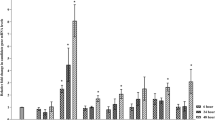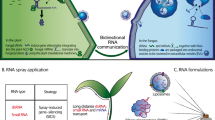Abstract
The Aspergillus giganteus antifungal protein (AFP), encoded by the afp gene, has been reported to possess in vitro antifungal activity against various economically important fungal pathogens, including the rice blast fungus Magnaporthe grisea. In this study, transgenic rice (Oryza sativa) constitutively expressing the afp gene was generated by Agrobacterium-mediated transformation. Two different DNA constructs containing either the afp cDNA sequence from Aspergillus or a chemically synthesized codon-optimized afp gene were introduced into rice plants. In both cases, the DNA region encoding the signal sequence from the tobacco AP24 gene was N-terminally fused to the coding sequence of the mature AFP protein. Transgenic rice plants showed stable integration and inheritance of the transgene. No effect on plant morphology was observed in the afp-expressing rice lines. The inhibitory activity of protein extracts prepared from leaves of afp plants on the in vitro growth of M. grisea indicated that the AFP protein produced by the trangenic rice plants was biologically active. Several of the T2 homozygous afp lines were challenged with M. grisea in a detached leaf infection assay. Transformants exhibited resistance to rice blast at various levels. Altogether, the results presented here indicate that AFP can be functionally expressed in rice plants for protection against the rice blast fungus M. grisea.
Similar content being viewed by others
References
Bonman, J.M. 1992. Blast. In: R.K. Webster and P.S. Gunnell (Eds.), Compendium of Rice Diseases. APS Press, St Paul, MN, pp. 14–17.
Bradford, M. 1976. A rapid and sensitive method for the quantification of microgram quantities utilizing the principle of protein-dye binding. Anal. Biochem. 72: 248–254.
Campos-Olivas, R., Bruix, M., Santoro, J., Lacadena, J., Martínez del Pozo, A., Gavilanes, J.G. and Rico, M. 1995. NMR solution structure of the antifungal protein from Aspergillus giganteus: evidence for cysteine pairing isomerism. Biochemistry 34: 3009–3021.
Carmona, M.J., Molina, A., Fernández, J.A., López-Fando, J.J. and García-Olmedo, F. 1993. Expression of the α-thionin gene from barley in tobacco confers enhanced resistance to bacterial pathogens. Plant J. 3: 457–462.
Cavallarin, L., Andreu, D. and San Segundo, B. 1998. Cecropin A-derived peptides are potent inhibitors of fungal plant pathogens. Mol. Plant-Microbe Interact. 11: 218–227.
Christensen, A.H. and Quail, P.H. 1996. Ubiquitin promoter based vectors for high level expression of selectable and/or screenable marker genes in monocotyledoneus plants. Transgenic Res. 5: 216–218.
Christensen, A.H., Scharrock, R.A. and Quail, P.J. 1992. Maize polyubiquitin genes: structure, thermal perturbation of expression and transcript splicing, and promoter activity following transfer to protoplasts by electroporation. Plant Mol. Biol. 18: 675–689.
Datta, S., Muthukrisnan, S. and Datta, S.K. 1999. Expression and function of PR proteins in transgenic plants. In: S.K. Datta and S. Muthudrishan (Eds.), Pathogenesis-Related Proteins in Plants, CRC Press, New York, pp. 261–277.
Epple, P., Apel, K. and Bohlmann, H. 1997. Overexpression of an endogenous thionin enhances resistance of Arabidopsis against Fusarium oxysporum. Plant Cell 9: 509–520.
Garcia-Olmedo, F., Molina, A., Alamillo, J.M. and Rodriguez-Palenzuela, P. 1998. Plant defense peptides. Biopolymers 47: 479–491.
Hood, E.E., Gelvin, S.B., Melchers, L.S. and Hoekema, A. 1993. New Agrobacterium helper plasmids for gene transfer to plants. Transgenic Res. 2: 208–218.
Horn, T. and Urdea, M.S. 1986. A chemical 5′-phosphorylation of oligonucleotides that can be monitored by trityl cation release. Tetrahedron Lett. 27: 4705–4708.
Iwai, T., Kaku, H., Honkura, R., Nakamura, S., Ochiai, H., Sasaki, T. and Ohashi, Y. 2002. Enhanced resistance to seed-transmitted bacterial diseases in transgenic rice plants overproducing an oat cell-wall-bound thionin. Mol. Plant-Microbe Interact. 15: 515–521.
Jach, G., Gornhardt, B., Mundy, J., Logemann, J., Pinsdorf, E., Leah, R., Schell, J. and Maas, C. 1995. Enhanced quantitative resistance against fungal disease by combinatorial expression of different barley antifungal proteins in transgenic tobacco. Plant J. 8: 97–103.
Lacadena, J., Martínez del Pozo, A., Barbero, J.L., Mancheño, J.M., Gasset, M., Oñaderra, M., López-Otín, C., Ortega, S., García, J. and Gavilanes, J.G. 1994. Overproduction and purification of biologically active native fungal α-sarcin in Escherichia coli. Gene 142: 147–151.
Lacadena, J., Martínez del Pozo, A., Gasset, M., Patiño, B., Campos-Olivas, R., Vázquez, C., Martínez-Ruiz, A., Mancheño, J.M., Oñaderra, M. and Gavilanes, J.G. 1995. Characterization of the antifungal protein secreted by the mold Aspergillus giganteus. Arch. Biochem. Biophys. 324: 237–281.
Laemmli, U.K. 1970. Cleavage of structural proteins during the assembly of the head of bacteriophage T4. Nature 277: 680–685.
Li, Q., Lawrence, C.B., Xing, H.-Y., Babbitt, R.A., Bass, W.T., Maiti, I.B. and Everett, N.P. 2001. Enhanced disease resistance conferred by expression of an antimicrobial magainin analog in transgenic tobacco. Planta 212: 635–639.
Logeman, J., Schell, J. and Willmitzer, L. 1987. Improved method for the isolation of RNA from plant tissues. Anal. Biochem. 163: 16–20.
Lorito, M. and Scala, F. 1999. Microbial genes expressed in transgenic plants to improve disease resistance. J. Plant Path. 81: 73–88.
Lorito, M., Harman, G.E., Hayes, C.K., Broadway, R.M., Tronsmo, A., Woo, S.L. and Di Pietro, A. 1993. Chitinolytic enzymes produced by Trichoderma harzianum: antifungal activity of purified endochitinase and chitobiosidase. Phytopathology 83: 302–307.
Lorito, M., Woo, S.L., García-Fernandez, I., Colucci, G., Harman, G.E., Pintor-Toro, J.A., Filippone, E., Muccifora, S., Lawrence, C.B., Zoina, A., Tuzun, S. and Scala, F. 1998. Genes from mycoparasitic fungi as a source for improving plant resistance to fungal pathogens. Proc. Natl. Acad. Sci. USA 95: 7860–7865.
Martínez-Ruiz, A., Martínez del Pozo, A., Lacadena, J., Mancheño, J.M., Oñaderra, M. and Gavilanes, J.G. 1997. Characterization of a natural larger form of the antifungal protein (AFP) from Aspergillus giganteus. Biochim. Biophys. Acta 1340: 81–87.
Matzke, A.J.M. and Matzke, M.A. 1998. Position effects and epigenetic silencing of plant transgenes. Curr. Opin. Plant Biol. 1: 142–148.
Melchers, L.S., Sela-Buurlage, M.B., Vloemans, S.A., Woloshuk, C.P., van Roekel, J.S.C., Pen, J., van den Elzen, P.J.M. and Cornelissen, B.J.C. 1993. Extracellular targeting of the vacuolar tobacco proteins AP24, chitinase and β-1,3-glucanase in transgenic plants. Plant Mol. Biol. 21: 583–593.
Mitsuhara, I., Matsufuru, H., Ohshima, M., Kaku, H., Nakajima, Y., Murai, N., Natori, S. and Ohashi, Y. 2000. Induced expression of sarcotoxin IA enhanced host resistance against both bacterial and fungal pathogens in transgenic tobacco. Mol. Plant-Microbe Interact. 13: 860–868.
Mourgues, F., Brisset, M.N. and Chevreau, E. 1998. Strategies to improve plant resistance to bacterial diseases through genetic engineering. Trends Biotech. 16: 203–210.
Murray, M.G. and Thompson, W.F. 1980. Rapid isolation of high molecular weight plant DNA. Nucl. Acids Res. 8: 4321–4325.
Nakaya, K., Omata, K., Okahashi, I., Nakamura, Y., Kolkenbrock, H. and Ulbrich, N. 1990. Amino acid sequence and disulfide bridges of an antifungal protein isolated from Aspergillus giganteus. Eur. J. Biochem. 193: 31–38.
Oldach, K.H., Becher, D. and Lörz, H. 2001. Heterologous expression of genes mediating enhanced fungal resistance in transgenic wheat. Mol. Plant-Microbe Interact. 14: 832–838.
Olson, B.H. and Goerner, G.L. 1965. α-Sarcin, a new antitumour agent. Isolation, purification, chemical composition, and identity of a new amino acid. Appl. Microbiol. 13: 314–321.
Osusky, M., Zhou, G., Osuska, L., Hancock, R.E., Kay, W.W. and Misra, A. 2000. Transgenic plants expressing cationic peptide chimeras exhibit broad-spectrum resistance to phytopathogens. Nature Biotech. 18: 1162–1166.
Ou, S.H. 1985. Rice Diseases, 2nd edn. Commonwealth Mycological Institute, Kew, UK.
Pons, M.J., Marfà, V., Melé, E. and Messeguer, J. 2000. Regeneration and genetic transformation of Spanish rice cultivars using mature embryos. Euphytica 114: 117–122.
Prodromou, Ch. and Pearl, L.H. 1992. Recursive PCR: a novel technique for total gene synthesis. Prot. Engin. 5: 827–829.
Rothman, J.E. 1987. Protein sorting by selective retention in the endoplasmic reticulum of the Golgi stack. Cell 50: 521–522.
Roumen, E., Levy, M. and Notteghem, J.L. 1997. Characterisation of the European pathogen population of Magnaporthe grisea by DNA fingerprinting and pathotype analysis. Eur. J. Plant Path. 103: 363–371.
Sallaud, C., Lorieux, M., Roumen, E., Tharreau, D., Berruyer, R., Svestasrani, P., Garsmeur, O., Ghesquiere, A. and Notteghem, J.L. 2003. Identification of five new blast resistance genes in the highly blast-resistant rice variety IR64 using a QTL mapping strategy. Theor. Appl. Genet. 106: 794–803.
Sambrook, J. and Russell, D.W. 2001. Molecular Cloning: A Laboratory Manual, 3rd edn. Cold Spring Harbor Laboratory Press, Plainview, NY.
Sharma, A., Sharma, R., Imamura, M., Yamakawa, M. and Machii, H. 2000. Transgenic expression of cecropin B, an antibacterial peptide from Bombyx mori, confers enhanced resistance to bacterial leaf blight in rice. FEBS Lett. 484: 7–11.
Somssich, I.E. and Halbrock, K. 1998. Pathogen defence in plants: a paradigm of biological complexity. Trends Plant Sci. 3: 86–90.
Terras, F.R.G., Eggermont, K., Kovaleva, V., Raikhel, N.V., Osborn, R.W., Kester, A., Rees, S.B., Torrekens, S., Van Leuven, F., Vanderleyden, J., Cammue, B.P.A. and Broekaert, W.F. 1995. Small cystein-rich antifungal proteins from radish: their role in host defense. Plant Cell 7: 573–588.
Toki, S., Takamatsu, S., Nojiri, C., Ooba, S., Anzai, H., Iwata, M., Christensen, A.H., Quail, P. and Uchimiya, H. 1992. Expression of a maize ubiquitin gene promoter-bar chimeric gene in transgenic rice plants. Plant Physiol. 100: 1503–1507.
Towbin, H., Staerhelin, T. and Gordon, J. 1979. Electrophoretic transfer of proteins from polyacrylamide gels to nitrocellulose sheets: procedures and some applications. Proc. Natl. Acad. Sci. USA 76: 43350–43354.
Vila, L., Lacadena, V., Fontanet, P., Martínez del Pozo, A. and San Segundo, B. 2001. A protein from the mold Aspergillus giganteus is a potent inhibitor of fungal plant pathogens. Mol. Plant-Microbe Interact. 14: 1327–1331.
Wnendt, S., Ulbrich, N. and Stahl, U. 1994. Molecular cloning, sequence analysis and expression of the gene encoding an antifungal-protein from Aspergillus giganteus. Curr. Genet. 25: 519–523.
Zasloff, M. 2002. Antimicrobial peptides of multicellular organisms. Nature 415: 389–395.
Zhu, Q., Maher, E.A., Masoud, S., Dixon, R.A. and Lamb, C.J. 1994. Enhanced protection against fungal attack by constitutive co-expression of chitinase and glucanase genes in transgenic tobacco. Biotechnology 12: 807–812.
Author information
Authors and Affiliations
Corresponding author
Rights and permissions
About this article
Cite this article
Coca, M., Bortolotti, C., Rufat, M. et al. Transgenic Rice Plants Expressing the Antifungal AFP Protein from Aspergillus Giganteus Show Enhanced Resistance to the Rice Blast Fungus Magnaporthe Grisea . Plant Mol Biol 54, 245–259 (2004). https://doi.org/10.1023/B:PLAN.0000028791.34706.80
Issue Date:
DOI: https://doi.org/10.1023/B:PLAN.0000028791.34706.80




